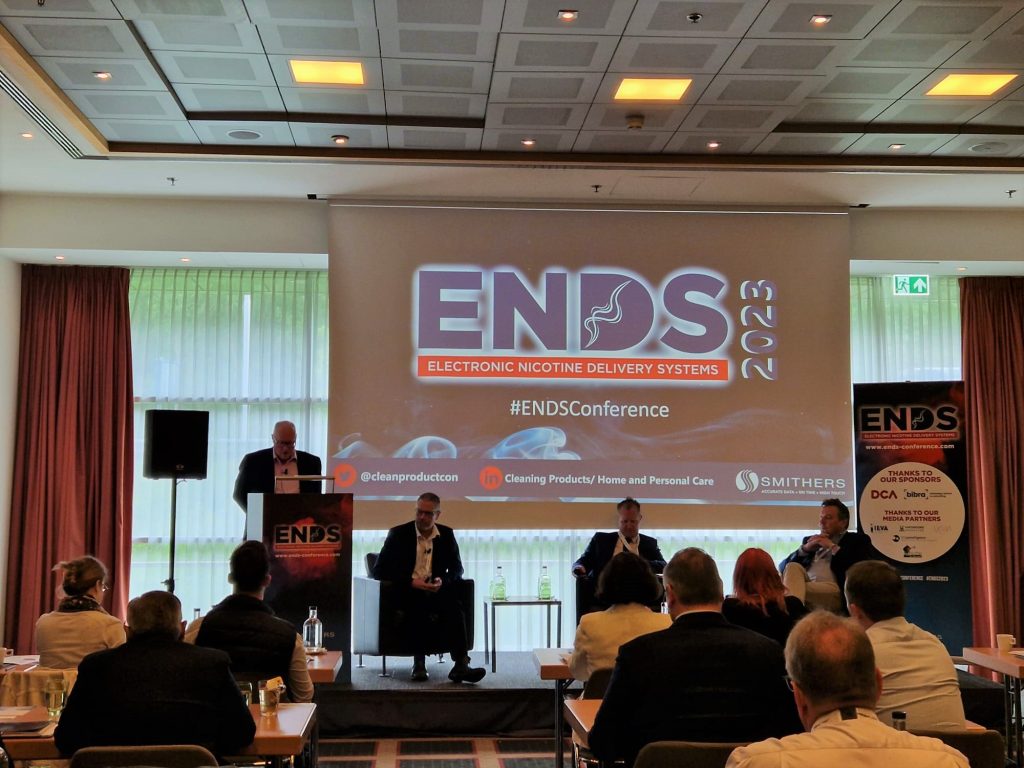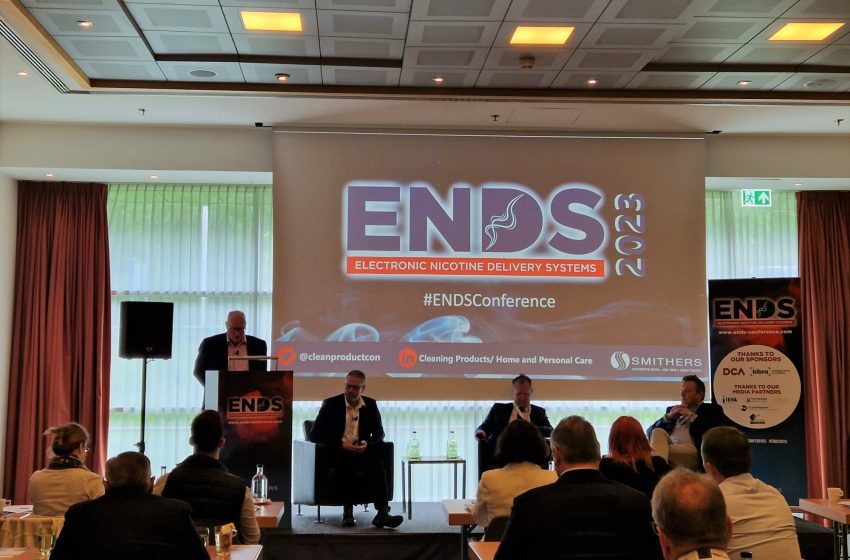
As tobacco harm reduction continues growing in influence, it is also facing many obstacles.
By Stefanie Rossel
Regulatory policies, industry standards and medicinal licensing were among the themes tackled during the May 23–24 ENDS Europe Conference in Amsterdam.
Many countries, including New Zealand and England, aim to be “smoke-free” by 2040, a term generally defined as less than 5 percent of the population lighting up. However, according to speakers at the event, most of these countries are unlikely to achieve their goals due to prohibitionist policies, such as incremental increases in purchase age, reductions in tobacco sales outlets or ultra-low-nicotine requirements.
The country most likely to achieve smoke-free status is Sweden, according to the conference participants. By helping smokers switch to less harmful alternatives, such as snus, it is living proof that tobacco harm reduction (THR) is a more effective strategy than prohibition to reduce tobacco-related illnesses.
Noting that millions of smokers don’t want to quit, Christopher Snowdon, head of lifestyle economics at the Institute of Economic Affairs in the U.K., presented an alternative, pragmatic and realistic smoke-free plan that includes a wide range of reduced-risk products (RRPs), such as snus, nicotine pouches, e-cigarettes and heated-tobacco products (HTPs), and focuses on educating consumers and fostering innovation. To put an end to misinformation about RRPs, Snowdon proposed the introduction of public information campaigns and cigarette pack inserts informing consumers in a band-neutral manner about the benefits of switching to less risky products.
He also asked for better regulation, including advertising, tank and bottle sizes and nicotine limits. For HTPs and nicotine pouches, Snowdon proposed proportional tax and regulation and independent research. He warned policymakers against overregulation, naming e-cigarette taxes, flavor bans or indoor vaping bans as examples. Anything that makes vaping, HTPs, snus or nicotine pouches less appealing will make smoking relatively more appealing, he cautioned.
More Challenges Ahead
Regulations, however, continue to mount. Ciprian Boboi, founder and board member of the Independent European Vape Alliance, provided an overview of upcoming EU laws that will affect the nicotine sector. The Battery Regulation, which will be adopted in June or July this year, stipulates that the batteries in portable devices must be removable and replaceable by the user. For disposable vapes, the new rules mean a de facto ban from January 2027. The Tobacco Products Directive (TPD), which is in revision until 2025/2026 and projected to be implemented by 2027/2028, may encourage the spread of flavor bans (which are already in force in five member states), plain packaging and advertising bans.
The Tobacco Excise Duty Directive (TED), to be implemented by 2025, is expected to include vaping. The Packaging and Packaging Waste Regulation requires all packaging to be recyclable by 2030. Plastic must contain a minimum percentage of recycled material. Provisions are likely to apply to packaging used by the vaping industry, including e-liquid bottles.
The upcoming TED, which aims to harmonize taxation of combustible cigarettes among member states based on the purchasing power parity index, was also the subject of a panel discussion. According to leaked information, the revised TED will tax e-liquids with a nicotine content of below 15 mg/mL (including zero nicotine liquids) at 20 percent, or €0.10 ($0.11)/mL, and those above 15 mg/mL at 40 percent, or €0.30/mL. HTPs will be taxed at 55 percent, or €91 per 1,000 sticks, nicotine pouches at 50 percent, or €120/kg, and other nicotine products at 50 percent, the latter two gradually over four years.
Panelists questioned the objective of the directive, arguing that if it was about health or nicotine, it was illogical to also tax non-nicotine liquids. By failing to follow the risk continuum, tax differentials would merely protect the cigarette trade and worsen the public’s already poor understanding of THR, according to panelists.
The global novel nicotine market is currently worth an estimated $56 billion, according to Marija Obradovic, head legal analyst at ECigIntelligence. Vape products are the predominant category in North America whereas HTPs are leading in Europe, the Middle East and Africa region and the Asia-Pacific region.
Nicotine pouches are steadily growing but face a fragmented regulatory framework in the EU. In several countries, among them Estonia, the Czech Republic and Sweden, they are regulated, with some states imposing packaging restrictions and requiring health warnings. In Bulgaria and Austria, there is a tax on modern oral nicotine products. For HTPs, a flavor ban will enter into force this October. Obradovic said the regulation will likely lead to more illicit markets, especially in eastern European countries bordering non-EU countries where flavors are not banned. Meanwhile, the number of herbal consumables for HTPs with or without nicotine, a totally unregulated market, has been growing.
Regulatory Approaches
When it comes to regulatory policies for RRPs, there are three approaches, as independent consultant Patricia Kovacevic explained. Regulatory science-based policies rely primarily on premarket notification with some elements of product science or standards. The EU TPD notification scheme is an example of this approach. Advantages of this stance include faster and more accessible market entry and a more diverse range of manufacturers, importers and products. Due to distinctions among national legislation, however, consistent success of electronic nicotine-delivery systems (ENDS) as a consumer product is impeded, and the approach does not include an element of scientific communication of the risk continuum. As flavor bans show, it is not always science-based.
By contrast, regulatory policies based on product science authorize market entry upon scientific review, including a comparative risk profile of products. The unit-by-unit review prevails in the U.S. under the Tobacco Control Act. While the approach is protective of the individual and, to some extent, public health, and robust science will eventually lead to a favorable outcome, it is a time-consuming, prohibitively complex, expensive and anticompetitive process that results in a limited number of products concentrated with a few large players, likely resulting in deceleration in harm reduction, according to Kovacevic.
The third approach—no effective premarket requirements—is followed by a dwindling number of countries. It allows easy market access but is not protective of public health. There are no standards and no oversight of product ingredients or functionalities. A regulatory approach that best serves THR, Kovacevic summarized, would include proportional and science-based product design, ingredients and manufacturing standards, reasonable liberties to communicate with adult consumers and would consider distribution, retail and age verification.
Regarding the future of global ENDS regulation, this November will see the 10th conference of the parties (COP10) to the World Health Organization Framework Convention on Tobacco Control (FCTC), to be staged in Panama. Jeannie Cameron, CEO of JCIC International, told the audience about the mechanisms behind the gathering’s decision-making, which takes place by consensus, not vote, and what to expect from the meeting. As the COP10 Bureau, the body that will be writing the agenda, consists of representatives of six countries, most of which have banned vaping, a pro-THR approach is unlikely.
Key issues on the FCTC agenda will likely include bringing novel nicotine products into the FCTC remit, a redefinition of smoke that includes aerosols, restriction of nicotine delivery and bans on nicotine salts in vaping products. COP10 will also discuss nicotine addiction, environmental issues and illicit trade.
As only governments have a say at the meeting, they will have to determine their views beforehand. Cameron recommended that to prepare for Panama, business and consumer advocates should contact small business and health committee members of Parliament, respectively, while political advocates should coordinate with like-minded countries.
Making Adjustments
In a presentation, Marina Murphy, director of scientific and medical affairs at ANDS, demonstrated that nicotine is not the evil substance anti-THR advocates make it out to be.
There is evidence that nicotine, an alkaloid like caffeine, could have a neuroprotective effect, she noted. Murphy pointed out that in nicotine product regulation, lawmakers apply widely varying standards, with cigarettes being regulated based on what comes out and e-cigarettes being regulated on what comes in, for example. With the WHO promoting nicotine flux—the rate at which nicotine flows from the mouth end of an e-cigarette per puff second—as a new regulatory target, she said it is time for the industry to reframe nicotine.
Righting misperceptions derived from flawed science can be helpful in this regard. Rosalia Emma, assistant professor at the Department of Clinical and Experimental Medicine at the University of Catania, reported on the Replica project at the Center of Excellence for Acceleration of Harm Reduction (COeHAR), in which researchers between 2019 and 2022 replicated the most relevant international studies and unequivocally demonstrated the reduced toxicity of e-cigarettes and HTPs. With Replica 2.0, a new phase of research has started this year, which repeats a study by Fetterman that suggested that flavorings in tobacco products induce endothelial cell dysfunction.
In contrast to the Fetterman study, COeHAR’s preliminary results show no significant differences in cell viability between PG/VG and PG/VG with vanillin. Reviewing recent literature about emission characterization, Sebastien Soulet, an engineer at Ingesciences, concluded that the contested studies used devices with high power and low airflow. He said that the condition of use should be investigated by researchers as there was a lack of information in many commissions and committees, including those that put together the FCTC’s nineth report, or the SCHEER report.
Compared to other age-restricted consumer products, such as combustible cigarettes or alcohol, vape products face a stronger regulatory, often prohibitionist stance, mainly because of the flavors involved—although these are also common in alcoholic beverages, according to speakers at the Amsterdam event. To make their products less prone to attack, panelists argued, the industry should behave more responsibly in the design and description of their products to prevent them from attracting youths. It should also develop a nomenclature to rule out violations, they suggested.
Rather than raising taxes on vape products, regulators should step up enforcement against retailers selling to youth, according to speakers. No longer subject to EU requirements, the U.K. should also consider allowing larger tank sizes, they suggested. This would make vapor products less appealing to youth due to higher prices.
The Flavor Issue
The conference also tackled the issue of flavors. In her Tobacco Products Prevalence Study, Andrea Patton, behavioral epidemiologist and head of prevalence research at the Centre for Substance Use Research, modelled the impact of an ENDS flavor ban on U.S. youth and adult users, developing two scenarios. Under the first, the U.S. Food and Drug Administration would ban all flavors except tobacco; under the second, the agency would ban all flavors except tobacco and menthol.
According to the study, the first scenario would result in a 31 percent reduction of vaping among current adult cigarette users while the second scenario would yield a 21 percent reduction. In both scenarios, participants stated that they would start using tobacco. Flavor, Patton concluded, was the main driver for quitting cigarettes. By contrast, only 5 percent of youths said that they vaped only because of flavors; the main reasons cited for vaping were anxiety, stress or depression. A flavor ban would thus not affect youth use as intended, according to Patton, who also stressed the importance for studies on youth use to look beyond the brand level.
Citing research by Konstantinos Farsalinos, Michael Landl, director of the World Vapers’ Alliance, explained the importance of flavors. Most vapers, Farsalinos’ work showed, use flavors other than tobacco. Over time, they will get “flavor fatigue” and hence need a variety of flavors. Flavor bans, he argued, won’t work as they make vaping less attractive to smokers, imply a never-ending “war on drugs” mentality and drive consumers to the black market.
In Estonia, where flavors have been banned since 2020, 58 percent of vapers still use flavors, he said—a real-life experience the Netherlands should have considered before enacting a similar ban. A flavor ban wouldn’t prevent youth uptake either, Landl argued, as most adolescents consumed nicotine for relief of psychological stress. To solve this problem, he asked politicians to improve the socioeconomic conditions and create better opportunities for disadvantaged adolescents.
Richard Young, principal toxicologist at Bibra Toxicology Advice and Consulting, identified aspects that vape manufacturers need to consider when carrying out assessing their products under TPD rules. He recommended getting a toxicologist involved early in the process—doing more extensive toxicity assessments, comparing acceptable levels or thresholds of toxicological concern for each ingredient to appropriate consumer exposures and documenting hazard and risk assessment clearly.
What THR Also Means

Three speakers shared their personal experiences with THR. Tom Gleeson, trustee of the New Nicotine Alliance Ireland, related how he, a smoker of 35 years, successfully quit within two days 12 years ago by trying an early vape product.
Flora Okereke, head of global regulatory insights and foresights at BAT, said that to her, a better future is to use and enjoy nicotine with little or no health impact, which she described as an achievable goal. Okereke made clear that leaving cigarettes, the cash cow for the tobacco industry, to an uncertain future was a bold step for a cigarette manufacturer. She called on the industry to unite and send a unified message to policy regulators. The industry, Okereke said, needed to use COP10 as an opportunity to shape where the industry will be heading.
Liam Humberstone, technical director at Totally Wicked, described his company’s strategy to deal with the waste created by disposable vapes. According to Nielsen, the U.K.’s single-use vape market was worth £1.12 billion ($1.38 billion) in May 2023, corresponding to 200 million pieces sold each year. In addition, there are an estimated 300 million illegal products.
Totally Wicked promises consumers it will take back any device of any brand, even illegal vapes. Products are recycled through some of the country’s few authorized treatment facilities, as their batteries are hazardous waste that needs separating. He pointed out that reducing, reusing and recycling makes sense—a lithium-ion battery, for instance, can be recharged 150 times to 300 times—but is not yet widely practiced. Concrete steps and appropriate regulations are needed to improve the situation, he claimed.
New Technologies
One way to accelerate THR is to offer licensed e-cigarettes on prescription. According to Ian Fearon of WhatIF? Consulting, doctors could prescribe vapes instead of less effective nicotine-replacement therapies. The best places for the medical licensing pathway, according to Fearon, are the U.K. and the U.S. Pete Lomas, managing consultant of product realization at Broughton, explained in detail what it takes to develop an ENDS product for medicinal licensing.
The ENDS Conference also highlighted innovative technologies. Stefanie Scheffler, scientist at the Fraunhofer Institute for Toxicology and Experimental Medicine, presented a novel device for standardized e-liquid testing. Capable of producing a defined and adjustable temperature, the prototype eliminates the influence of the vaping device on aerosol emissions and creates more safety for the user, independent from the e-cigarette used.
Scientific Horizons Consulting launched a new puff-recording ENDS that allows researchers to assess real-world user behaviors in real time. According to the company’s principal scientist, Xiang Gao, a two-month observation study revealed that users had vastly varying, complex and nonlinear puff behavior patterns.

